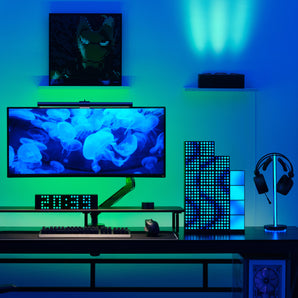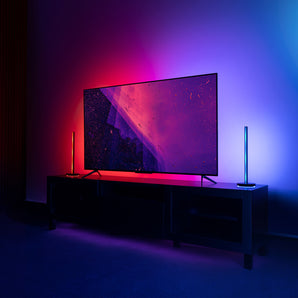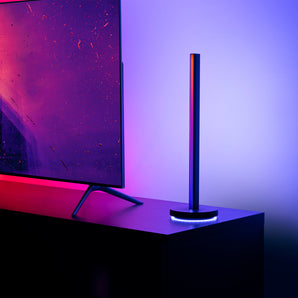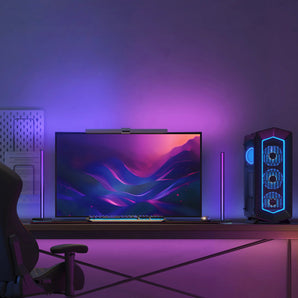More than most of us realize, light plays a significant role in your sleep cycle.
One fascinating finding from studies is that light may not be the only factor influencing our circadian rhythms; the hue of the light may also play a role.
If you have to sleep with a night light on, you might question if the hue of the LED light is troubling your sleep. Actually, if you have white or blue lights in your bedroom, you should exercise caution and think twice. According to a new study, blue light had the greatest impact on mood, followed by white light. If the light color is blue or white, we will not feel peaceful or quiet before sleeping. So, what is the best LED color to sleep with?
So, Which Color LED light is Best for Bedroom

Image credit: www.mydimmerswitch.com
Red light has a lower color temperature than typical sunlight, making it ideal for sleeping. Red light may be used at night without jolting your body or disrupting your internal clock, as blue light does. If you’re having difficulties sleeping and are constantly exposed to artificial blue light, this is most certainly a contributing reason. In the evenings, switching to natural red hue might assist your body in transitioning more smoothly into its sleep cycle.
Best LED light for Bedroom—Yeelight Sunset Projection Lamp

Specification:
Size: 3.47″*3.2″
Usage Time: About 2 hours (always on)
Rated input: 5V DC / 1A
Power: 3W
Yeelight Sunset Projection Lamp is a night light and atmosphere light suitable for bedrooms. It provides you with the light that is close to the natural sunset to the maximum extent, and adds a touch of reddish, dreamy vibe to your bedroom décor. You can bring the ambiance light to your bedroom, enjoy the soothing, romantic moment. When the warm golden hour shines on your face, it is hard to not fall asleep.
With a head design that allows 360-degree rotation, this lamp can produce different lights from different angles. The shape and size of the halo can also be changed by rotating the lamp, affording endless possibilities.
With high-quality ABS material and high transmission glass optical lens, the lamp produces no unpleasant odor. COB light source features energy-saving, corrosion resistance, anti-glare, and long service life. It ensures that your bedroom lighting environment is safe and healthy, making it the best LED light to sleep with.
How Does Light Color Help You with Sleep?
When you stare at a bright, somewhat blue light, such as that from your smartphone or television, your body sends a signal to your brain telling it to cease creating melatonin, a powerful hormone that aids sleep.
The normal synchronous relationships between sleep and daytime activity and cortisol, melatonin and body temperature.

Image credit: ResearchGate
Unfortunately, waking up in the middle of the night, either because of a kid or because our bodies can’t seem to relax, is an all-too-common experience for many of us, and the repercussions may have a lasting impact on the rest of the day.
When many individuals have problems getting back to sleep, they make the same mistake: they turn on a bright light bulb in the middle of the night.
For a long time, we’ve known that blue light may disrupt our bodies’ internal clocks. Our light-emitting e-readers were discovered to be disrupting our sleep by inhibiting melatonin production in our bodies and boosting a sense of awakeness.
Other Calming LED Light Colors for Sleep
If you don’t have a red light, you may use other light colors instead, such as light yellow, pink, or other colors that tend toward red, but if you don’t need the lights on, absolute darkness is also a fine alternative.
However, if you are terrified of the dark and must keep the lights on while sleeping, a reddish light rather than white light may be preferable.
Get the Brightness Right for Your Bedroom
Determining the appropriate quantity of light for a given bedroom may be tricky. To do so, you must have the appropriate quantity of lumens. What is Lumen? Lumens, referred to as the Lumen/Watt ratio (Lm/W), represent the total amount of light given off by a light source, regardless of direction. This metric is particularly useful for assessing the efficiency of a light source.
In this regard, you may also come across the term lux. Simply put, the lux (unit: lx) is the illuminance unit that measures light flux per unit area. It indicates one lumen per square meter. In photometry, it is applied to calculate the intensity of light that hits or passes through a surface as perceived by the human eye.
To acquire the proper light, you must first identify the various places that need to be illuminated. There are some areas that require more lights (such as the kitchen), and for bedrooms and the like, the requirement for lumens is generally less. To get the correct number of lumens for a specific location, you need to split the amount needed across various light sources. Suppose 2500 lumens are what you need, for example, you cannot purchase a single fixture that produces 2500 lumens; to achieve this level, you may need three or four light sources.
The lumens will be determined by a variety of criteria, including the form and size of the space, the ceilings height, the type of lamps, and your demands as a user. Here is a brief guide to assist you:
| Area | Lumens/squaremeter |
| Bedroom | 300-400 |
| Kitchen | 300-400 |
| Bedroom (task) | 700-800 |
| Kitchen (task) | 700-800 |
| Livingroom | 400-500 |
| Bathroom | 500-600 |
| Bathroom (task) | 700-800 |
| Hallway | 300 |
For elders, a sound sleep may be more easily disturbed by various factors, including light colors, lumens, etc. Therefore, it is recommended to utilize lights that are low in both lx and color temperature to create a cozy and peaceful environment for a solid sleep.





